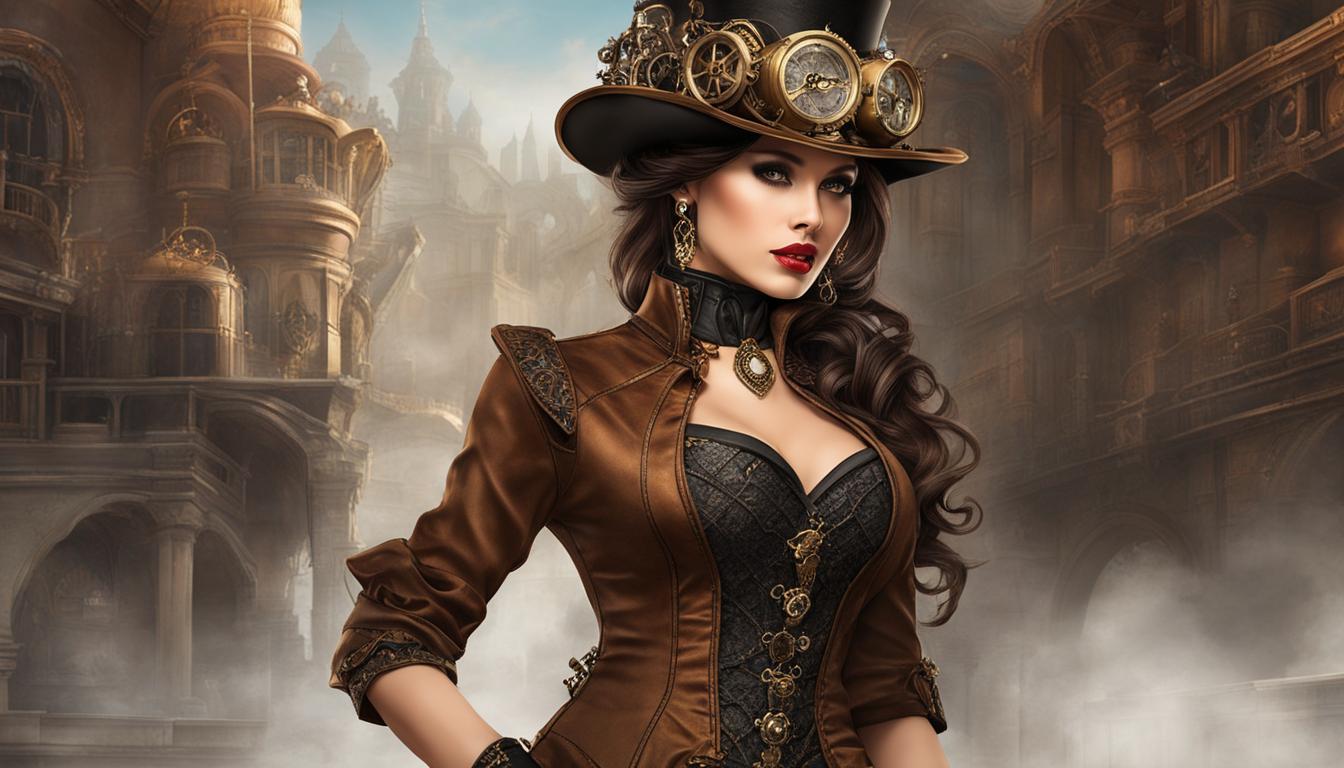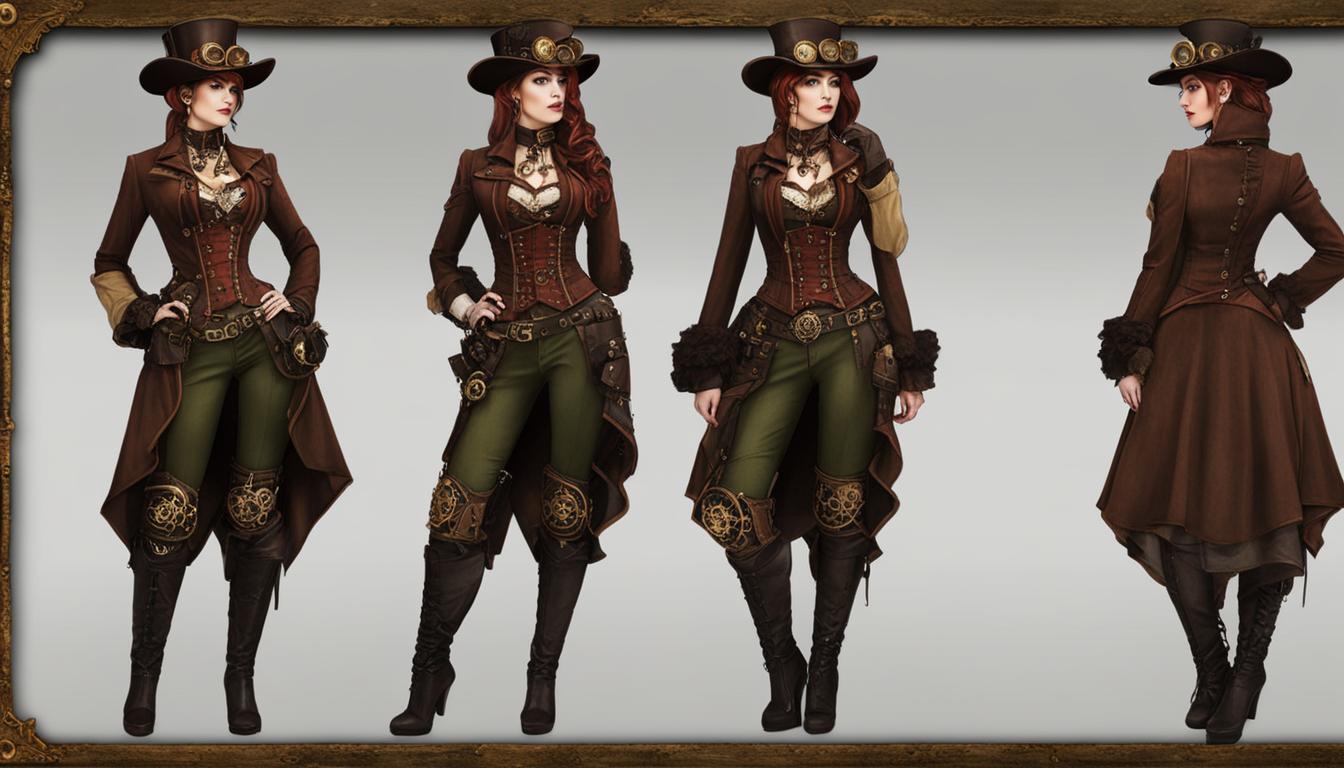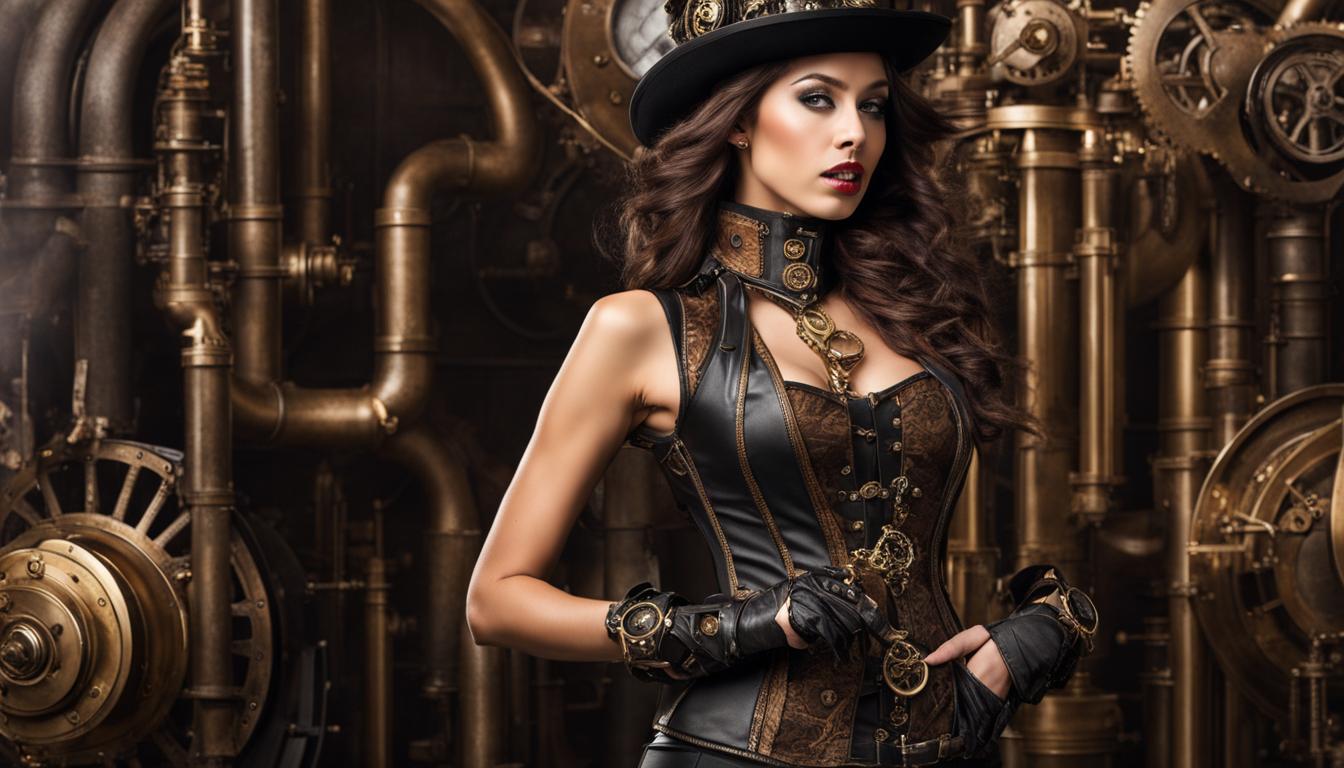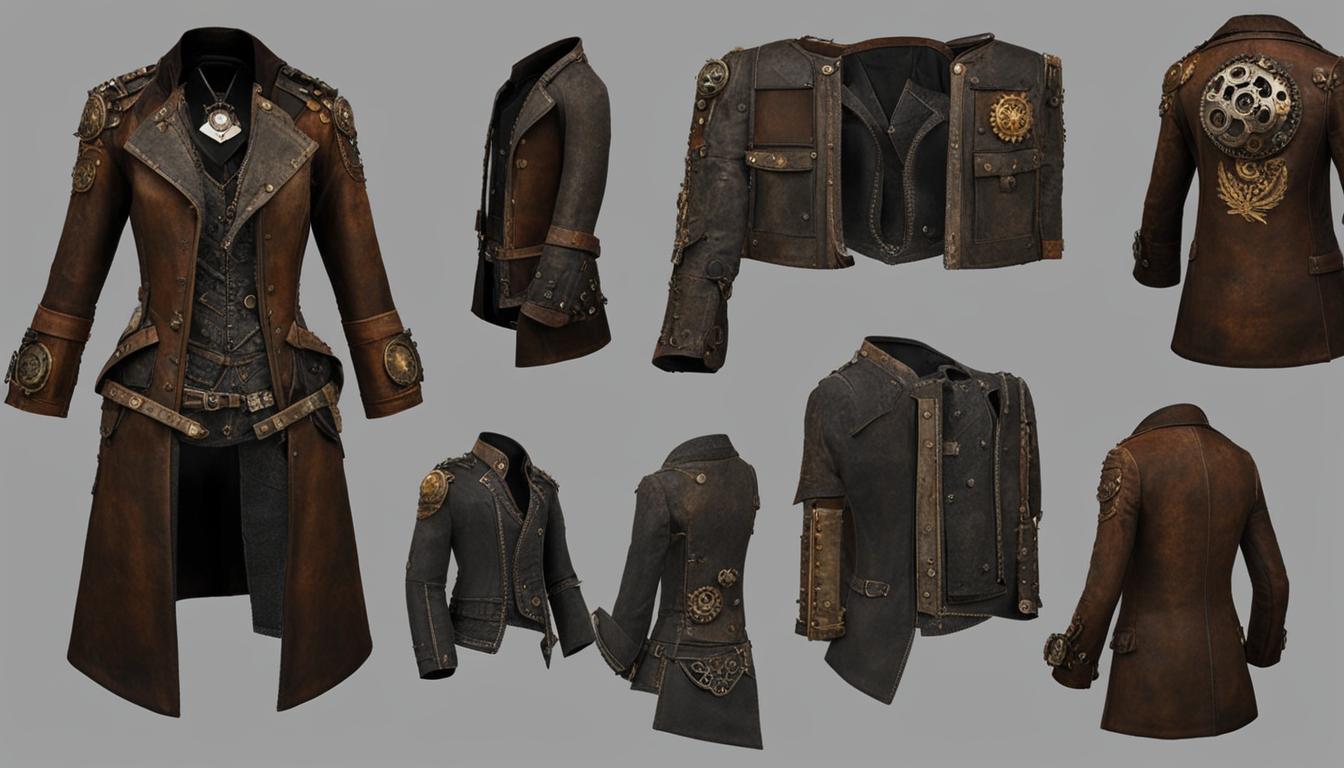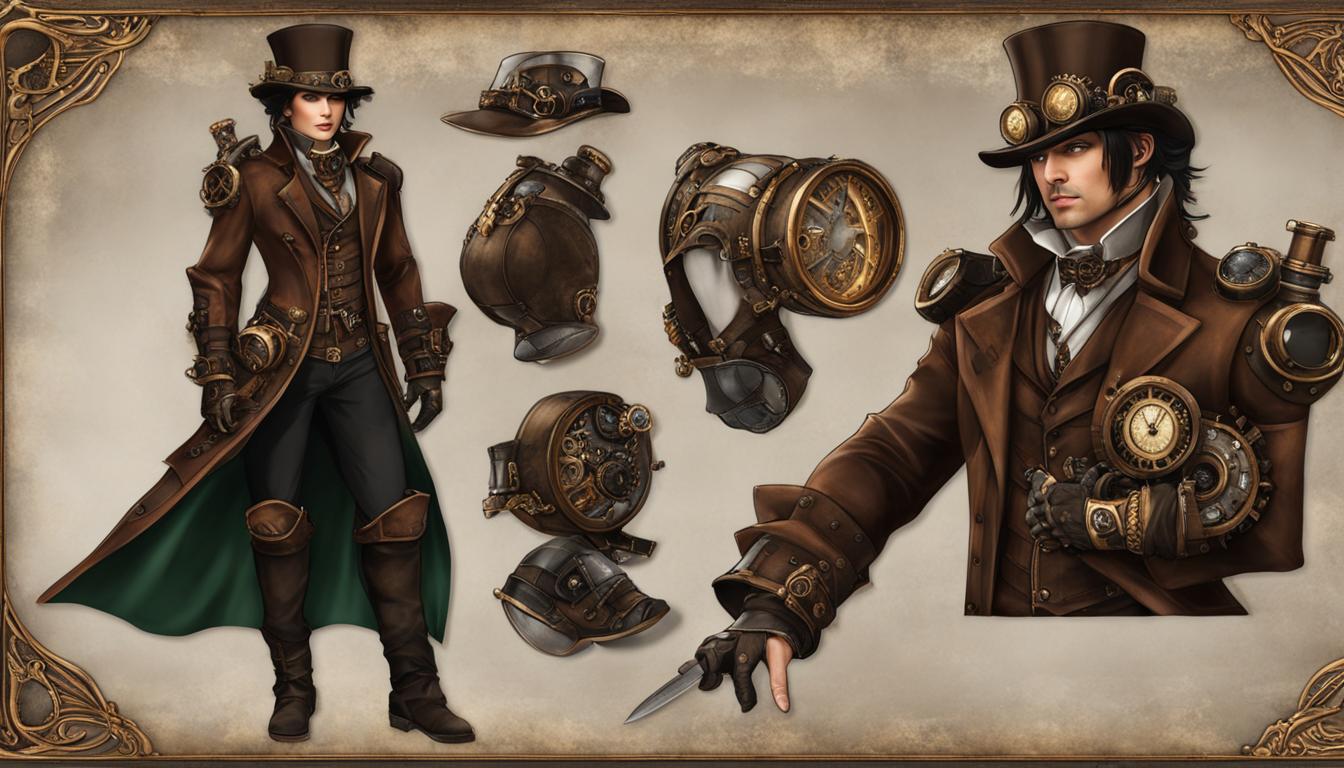Step into a world where elegance and innovation collide, as haute couture meets the captivating aesthetic of steampunk fashion. This unique blend of luxury and edginess creates a style that is both mysterious and breathtaking. Explore the intricate designs and industrial-inspired elements that define this avant-garde trend.
Key Takeaways:
- Haute couture and steampunk fashion converge, resulting in a fusion that bridges elegance and mechanical innovation.
- Steampunk fashion draws inspiration from the Victorian era and the industrialization of Europe during the 1800s.
- Literature, both from the 19th century and modern steampunk works, greatly influences the development of steampunk fashion.
- Steampunk fashion embraces an alternate history aesthetic, combining elements of fantasy, science fiction, and Victorian spiritualism.
- Steampunk fashion incorporates various historical and contemporary styles, including influences from punk, goth, and burlesque fashion.
A Brief History of Steampunk Fashion
Steampunk fashion, with its unique blend of Victorian era influences and Industrial Revolution inspiration, has a rich and fascinating history. It emerged from the steampunk movement in science fiction, drawing inspiration from the romanticized view of science in Victorian literature and the industrialization of Europe during the 1800s.
This fashion style incorporates elements from the Victorian era, such as corsets, waistcoats, and top hats, while also embracing the aesthetics of a post-apocalyptic world. Initially, steampunk fashion was mostly handmade and customized, with individuals creating their own unique ensembles. However, it has now evolved into a mass-produced industry, with designers and brands catering to the growing demand for this captivating style.
Throughout its history, steampunk fashion has been deeply influenced by literature. Writers such as Robert Louis Stevenson, G.K. Chesterton, and Sir Arthur Conan Doyle have played a significant role in shaping the aesthetic of steampunk fashion through their depictions of the Victorian era and its industrialized landscapes. Modern steampunk literature also contributes to the fashion’s development, with authors creating fantasy tales set in cultures with Victorian-style aesthetics.
| Steampunk Fashion History | Victorian Era Influences | Industrial Revolution Inspiration |
|---|---|---|
| Originated from the steampunk movement in science fiction | Incorporates elements from the Victorian era | Draws inspiration from the industrialization of Europe during the 1800s |
| Combines the aesthetics of high fashion with the edgy elements of the steampunk subculture | Corsets, waistcoats, and top hats are iconic elements of steampunk fashion | Embraces the industrial-inspired aesthetic of the steampunk movement |
| Initially handmade and customized, now a mass-produced industry | Depictions of the Victorian era in literature have influenced steampunk fashion | Authors create fantasy tales with Victorian-style aesthetics, shaping steampunk fashion |
Steampunk fashion continues to captivate and intrigue fashion enthusiasts around the world. With its rich history, unique style, and influence from literature, it offers a fresh and daring approach to fashion that bridges the gap between the past and the future.
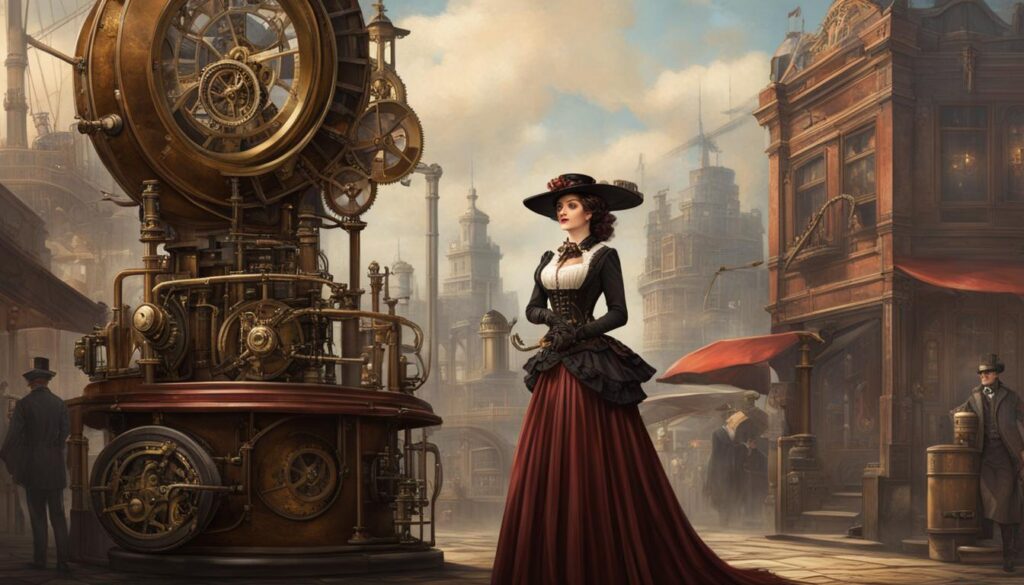
The Influence of Literature
Steampunk fashion has been greatly influenced by the literary works of renowned authors. Robert Louis Stevenson’s “Strange Case of Dr. Jekyll and Mr. Hyde” and “Treasure Island” introduced readers to the mysterious world of London during the Victorian era, inspiring elements of the fashion style. G.K. Chesterton’s “The Man Who Was Thursday” and Sir Arthur Conan Doyle’s Sherlock Holmes stories also contributed to the literary foundation of steampunk fashion.
These authors painted vivid pictures of industrialized London, filled with steam-powered machinery, clockwork contraptions, and eccentric characters. The imaginative worlds they created serve as a rich source of inspiration for steampunk fashion designers and enthusiasts.
Modern steampunk literature continues to shape the fashion, with authors like Cherie Priest, Gail Carriger, and China Miéville crafting intricate tales set in alternate histories with Victorian-style aesthetics. Their writings provide a platform for the evolution and creativity of steampunk fashion, pushing boundaries and expanding the limits of this unique style.
Influence of Literature on Steampunk Fashion
Steampunk fashion has been greatly influenced by the works of renowned writers from the late 19th century. Authors such as Robert Louis Stevenson, G.K. Chesterton, and Sir Arthur Conan Doyle painted vivid pictures of the industrialized London of the Victorian era in their literature, which serves as a rich source of inspiration for steampunk fashion. These literary works, filled with adventure, mystery, and innovation, have helped shape the aesthetic and themes found within the steampunk subculture.
Robert Louis Stevenson’s “Strange Case of Dr. Jekyll and Mr. Hyde” explores the duality of human nature, a theme that resonates deeply within the steampunk community. G.K. Chesterton’s “The Man Who Was Thursday” delves into the world of espionage and intrigue, which mirrors the clandestine and mysterious aspects of steampunk fashion. Sir Arthur Conan Doyle’s famous detective character, Sherlock Holmes, with his keen eye for detail and eccentric personality, has become an iconic figure in the steampunk genre.
“Steampunk fashion draws inspiration from the rich tapestry of Victorian literature, bringing to life the fantastical elements and adventurous spirit found within these works.” – Fashion historian, Jane Thompson
The influence of literature on steampunk fashion extends beyond the classic works of the late 19th century. Modern steampunk authors, such as Cherie Priest and Gail Carriger, have continued to shape the fashion with their imaginative tales set in cultures that embrace Victorian-style aesthetics. Their novels breathe new life into the fusion of history, science fiction, and fantasy that defines the steampunk subculture, inspiring fashion enthusiasts to create their own unique interpretations of this captivating style.
Steampunk Literary Influences
Below is a table showcasing some of the key literary works that have influenced steampunk fashion:
| Literary Work | Author | Influence on Steampunk Fashion |
|---|---|---|
| “Strange Case of Dr. Jekyll and Mr. Hyde” | Robert Louis Stevenson | Exploration of duality and transformation |
| “The Man Who Was Thursday” | G.K. Chesterton | Intrigue and espionage |
| Sherlock Holmes Series | Sir Arthur Conan Doyle | Detective work and eccentricity |
These literary influences continue to shape the ever-evolving landscape of steampunk fashion, infusing it with a sense of adventure, creativity, and nostalgia.
The Aesthetic of Steampunk Fashion
Steampunk fashion is more than just a style; it is a unique aesthetic that transports us to an alternate history where Victorian elegance meets industrial innovation. With its blend of fantasy, science fiction, and Victorian spiritualism, steampunk fashion captures the imagination and allows us to envision a world where the past shapes the future. The aesthetic of steampunk fashion embraces archetypes such as valiant explorers, debonair aviators, and gentlemen with a lab coat over formal clothes, creating a visual narrative that is both captivating and mysterious.
One of the defining characteristics of steampunk fashion is its emphasis on alternate history. It invites us to imagine a world where the Victorian era continued to flourish, where steam power and mechanical marvels became the driving force of technology. This alternate history is expressed through intricate details, such as brass accessories, corsets, goggles, and hats, which serve as symbols of the fusion between elegance and industrialism.
Another significant influence on the aesthetic of steampunk fashion is Victorian spiritualism. During the Victorian era, spiritualism was a popular belief system that centered around communication with the dead and the exploration of the spiritual realm. Steampunk fashion incorporates elements of this spiritualism, with symbols of mysticism and the occult often woven into the fabric of the garments. This combination of historical inspiration and mystical elements creates a unique and visually striking aesthetic that sets steampunk fashion apart.
Steampunk fashion is a journey into a world that never was, a whimsical exploration of what could have been. It allows us to indulge in the romance of the past while imagining a future infused with the wonders of steam power and invention.
From its roots in science fiction and literature to its presence in popular culture and high-end fashion, steampunk fashion continues to captivate and inspire. Its aesthetic of alternate history and Victorian spiritualism offers a refreshing departure from traditional fashion, inviting us to embrace our imagination, creativity, and a sense of adventure. With its intricate details, unique silhouettes, and rich symbolism, steampunk fashion remains a timeless and enigmatic expression of style.
| Steampunk Fashion Aesthetic | Key Elements |
|---|---|
| Alternate History | Brass accessories, corsets, goggles, hats |
| Victorian Spiritualism | Mystical symbols, occult-inspired designs |
| Archetypes | Valiant explorers, debonair aviators, gentlemen with lab coats |
| Inspiration | Science fiction, literature, popular culture |
| Impact | Transformative, captivating, mysterious |
Steampunk Fashion Styles and Influences
Steampunk fashion embraces a wide range of historical and contemporary styles, blending them together to create a unique and captivating aesthetic. Drawing inspiration from the 19th century Victorian era, steampunk fashion incorporates elements of punk, goth, burlesque, and fetish fashion. It is a style that merges the elegance of the past with the edginess of modern subcultures.
One notable influence on steampunk fashion is the Lolita fashion movement. While both styles share a fascination with the Victorian era, steampunk fashion tends to be more personalized and individualistic. Lolita fashion focuses on a youthful and girlish aesthetic, characterized by frilly dresses, petticoats, and elaborate accessories. Steampunk fashion, on the other hand, incorporates Victorian-inspired clothing with a mechanical twist, often incorporating gears, goggles, and other industrial elements.
To understand the diverse nature of steampunk fashion, let’s explore some of its historical and contemporary trends:
Historical Trends
In the realm of historical trends, steampunk fashion takes inspiration from various periods, primarily the Victorian era. This includes corsets, bustle skirts, top hats, and waistcoats, which were popular during the 1800s. The fashion also incorporates elements from the Industrial Revolution, such as gears, clockwork mechanisms, and steam-powered machinery. These elements add an industrial and mechanical touch to the traditional Victorian attire, creating a unique blend of elegance and innovation.
Contemporary Trends
Steampunk fashion has also evolved to incorporate contemporary trends and subcultures. It integrates elements of punk fashion, with its rebellious and anti-establishment vibe, including leather jackets, studs, and unconventional accessories. Gothic influences can be seen in the use of dark colors, lace, and Victorian mourning attire. Burlesque and fetish fashion contribute to the sensual and provocative aspects of steampunk, with corsets, stockings, and intricate lingerie-inspired details.
Overall, steampunk fashion is a versatile and ever-evolving style that draws inspiration from various historical and contemporary trends. By fusing elements of the past with modern subcultures, it creates a visually rich and intellectually stimulating fashion movement that continues to captivate and intrigue fashion enthusiasts around the world.
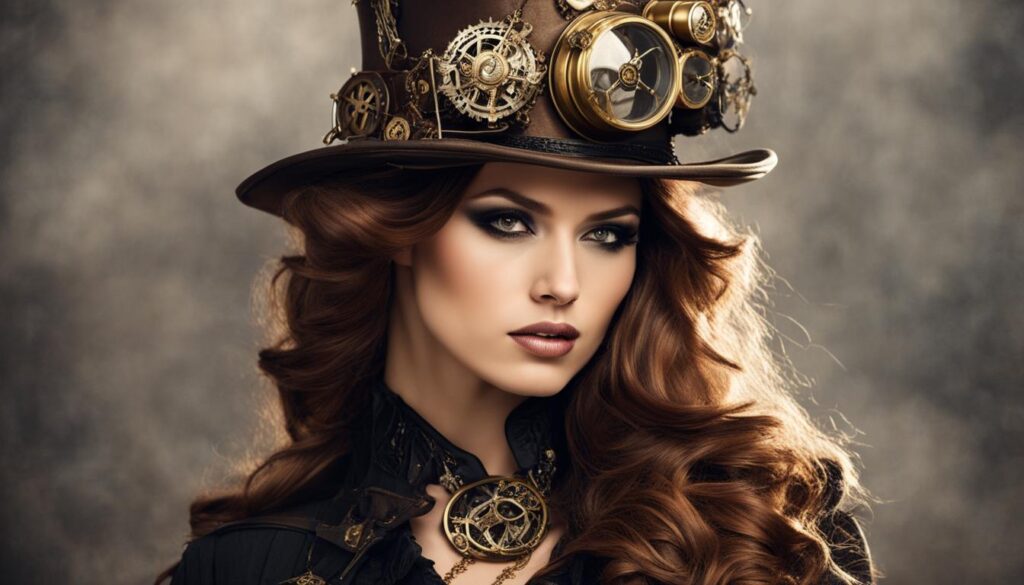
| Historical Trends | Contemporary Trends |
|---|---|
| – Victorian-era clothing – Industrial Revolution inspiration – Corsets, bustle skirts, top hats |
– Punk fashion influences – Gothic aesthetics – Burlesque and fetish elements |
| – Gears, clockwork mechanisms, and steam-powered machinery | – Leather jackets, studs, and unconventional accessories |
| – Dark colors, lace, and Victorian mourning attire | |
| – Sensual and provocative details |
Steampunk Fashion in Popular Culture
Steampunk fashion has transcended its subcultural roots and found its way into popular culture. From films to TV shows and music videos, the influence of steampunk can be seen in various forms of entertainment. Movies like “Sherlock Holmes” and “The Golden Compass” incorporate steampunk elements in their set designs and costumes, immersing the audience in a world of mechanical wonders and Victorian aesthetics. Steampunk-themed TV episodes, such as those featured in “Castle” and “America’s Next Top Model,” have dedicated segments to explore the unique style and creativity of steampunk fashion.
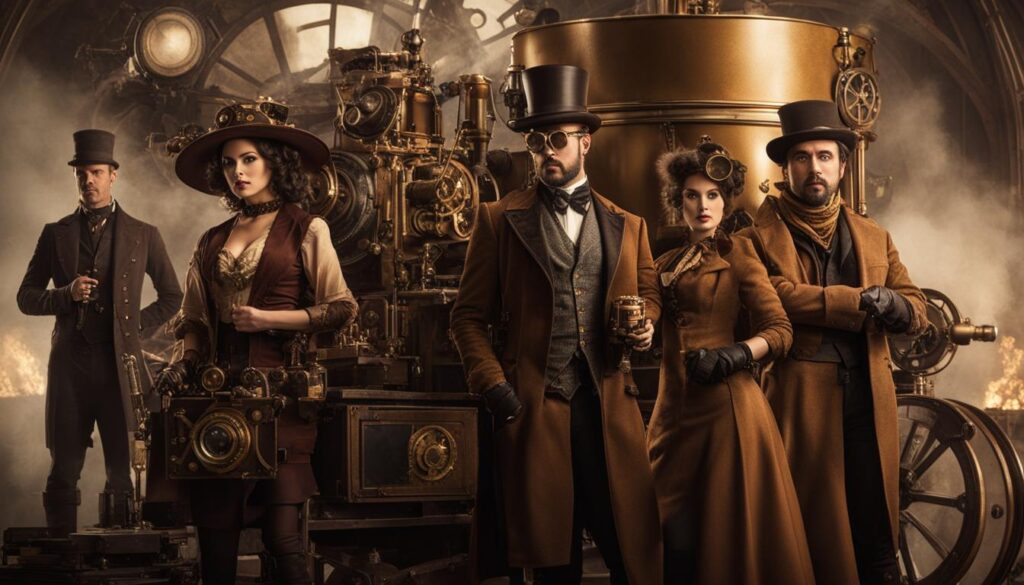
Music videos have also embraced the steampunk aesthetic, with artists like Lindsey Stirling and bands like Abney Park incorporating it into their performances. These music videos transport viewers to fantastical realms where steam-powered contraptions and retro-futuristic fashion reign supreme. The fusion of music and steampunk visuals creates a captivating experience that resonates with audiences and further popularizes the style.
Steampunk fashion’s presence in popular culture serves as a testament to its enduring appeal and artistic influence. Through film, television, and music, it continues to inspire and captivate audiences worldwide. Whether it’s the grandeur of a steampunk-inspired film set or the mesmerizing choreography of a music video, the allure of steampunk fashion in popular culture shows no signs of waning.
Steampunk Fashion in High-End Design
Steampunk fashion has not only left its mark in subcultures and popular culture but has also made its way into the realm of high-end design. Renowned fashion designers such as John Galliano and Jean Paul Gaultier have embraced the steampunk aesthetic and collaborated with the subculture, bringing its unique style to the forefront of haute couture.
John Galliano, known for his avant-garde designs, showcased a collection in 2010 that incorporated elements of steampunk fashion. The runway show featured models adorned with top hats, corsets, and goggles, all reminiscent of the steampunk subculture. Galliano’s collaboration with steampunk fashion introduced the style to a wider audience and challenged traditional notions of haute couture.
Jean Paul Gaultier also embraced the steampunk influence in his designs. In his 2013 collection, Gaultier showcased a range of garments that blended Victorian-inspired silhouettes with industrial elements. The collection featured corsets, bustles, and intricate details, all infused with a modern twist. Gaultier’s collaboration with steampunk fashion demonstrated the versatility and creativity that can be achieved when two distinct worlds collide.
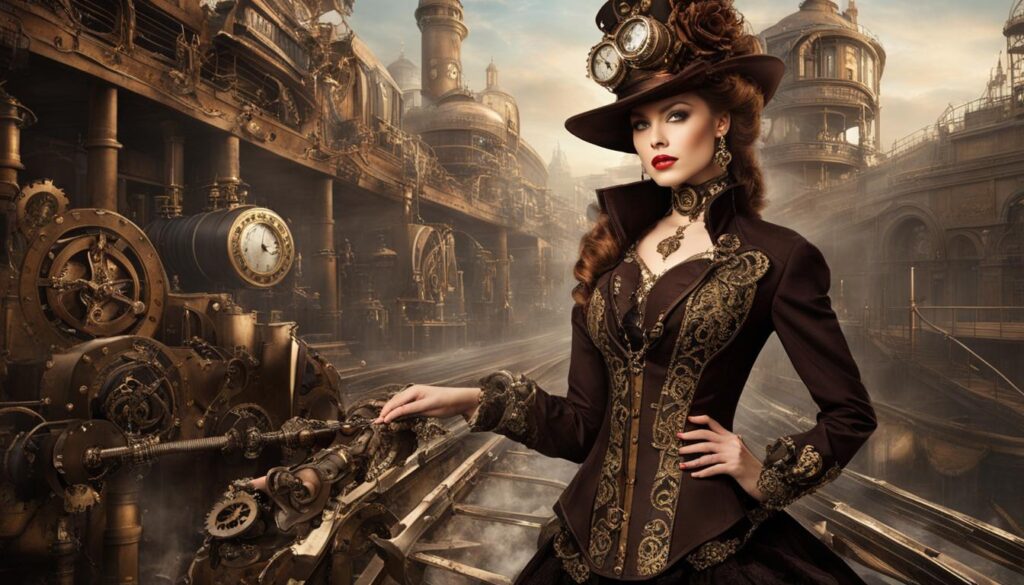
These designer collaborations have elevated steampunk fashion to new heights, challenging the boundaries of traditional haute couture. By incorporating the steampunk aesthetic into their collections, Galliano and Gaultier have brought a fresh and daring approach to high-end design. Their creations have captivated the fashion world, inspiring other designers to experiment with the fusion of elegance and steampunk elements.
Conclusion
Steampunk fashion, with its unique blend of haute couture elegance and edgy steampunk aesthetics, is paving its way into the fashion industry. This daring and captivating style offers a fresh approach to fashion, capturing the imagination of fashion enthusiasts worldwide. As designers embrace the subculture and incorporate it into their collections, steampunk fashion is gaining popularity and influencing mainstream trends.
The future of steampunk in haute couture looks promising, as it continues to evolve and inspire. Its avant-garde nature pushes boundaries and challenges traditional fashion norms. Steampunk fashion embodies the spirit of creativity, blending the elegance of high-end design with the ruggedness of industrial-inspired elements. The result is a stylistic masterpiece that intrigues and captivates fashion lovers.
As we look ahead, we can expect to see the influence of steampunk fashion continue to grow. Its fusion of historical and contemporary styles, along with its focus on personalization and uniqueness, sets it apart from other fashion trends. Steampunk fashion will continue to captivate the fashion world with its intricate designs, intricate accessories, and bold creativity. Whether it’s on the runway or in the streets, haute couture steampunk is here to stay, shaping the future of fashion.
FAQ
What is steampunk fashion?
Steampunk fashion is a unique blend of elegant haute couture and edgy steampunk subculture elements, combining intricate designs with industrial-inspired aesthetics.
Where did steampunk fashion originate from?
Steampunk fashion originated from the steampunk movement in science fiction, drawing inspiration from Victorian literature and the industrialization of Europe in the 1800s.
What elements are included in steampunk fashion?
Steampunk fashion includes clothing, hairstyling, jewelry, body modification, and makeup, all influenced by Victorian aesthetics and a post-apocalyptic world.
Who has influenced steampunk fashion?
Writers from the late 19th century, such as Robert Louis Stevenson and Sir Arthur Conan Doyle, have greatly influenced steampunk fashion with their depictions of industrialized London.
How is steampunk fashion related to other fashion styles?
Steampunk fashion is a blend of historical and contemporary styles, incorporating Victorian-era clothing and influences from punk, goth, burlesque, fetish fashion, and even the Lolita fashion.
Where can steampunk fashion be seen in popular culture?
Steampunk fashion has made appearances in films like “Sherlock Holmes” and TV shows like “Castle,” as well as music videos by artists like Lindsey Stirling and bands like Abney Park.
Has steampunk fashion reached the world of high-end design?
Yes, renowned designers like John Galliano and Jean Paul Gaultier have incorporated steampunk elements into their collections, bringing the style to prestigious fashion houses.
How does steampunk fashion continue to evolve?
Steampunk fashion continues to inspire and influence mainstream trends as designers embrace the subculture and incorporate it into their collections, captivating fashion enthusiasts worldwide.

